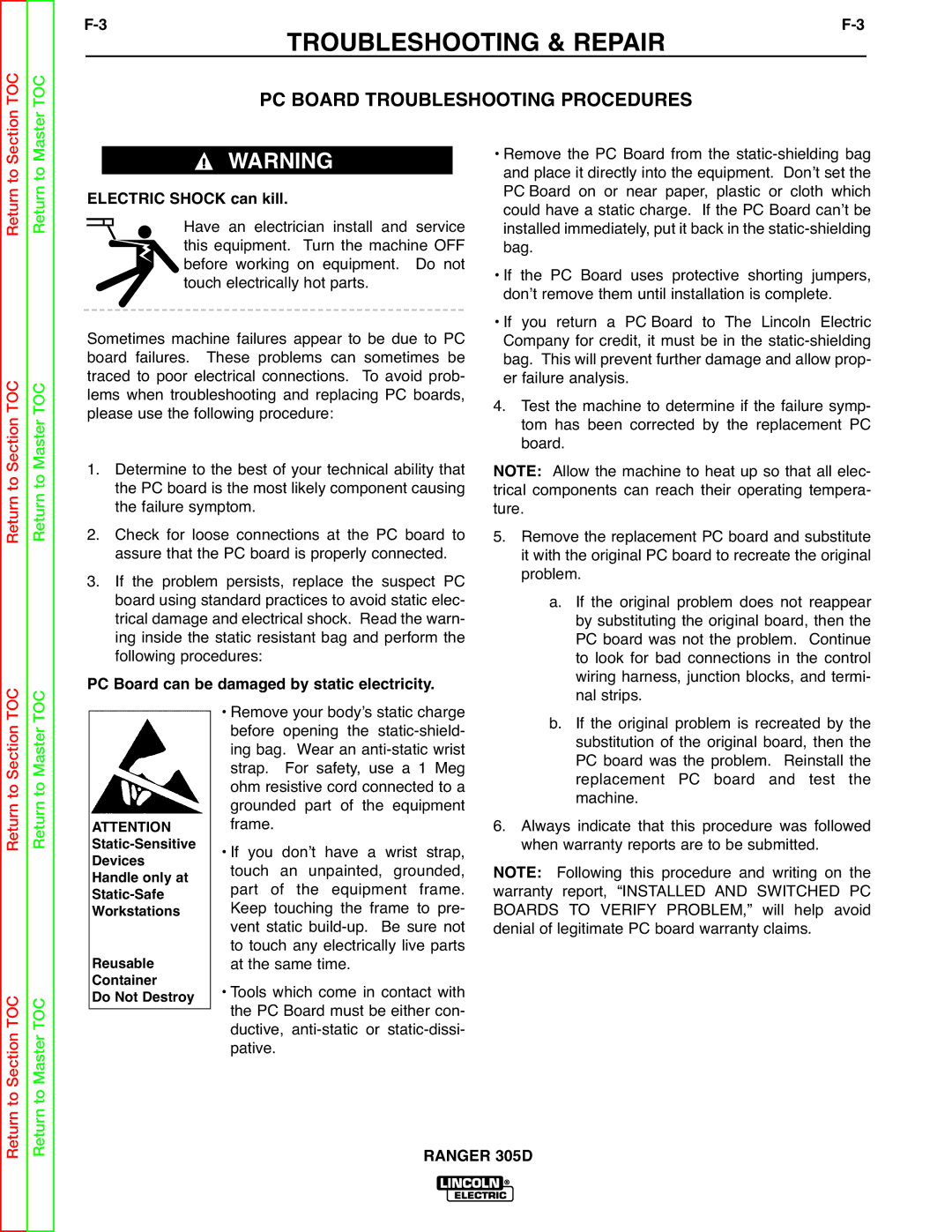
TOC
TOC
F-3 F-3
TROUBLESHOOTING & REPAIR
PC BOARD TROUBLESHOOTING PROCEDURES
Return to Section
Return to Section TOC
Return to Section TOC
to Section TOC
Return to Master
Return to Master TOC
Return to Master TOC
to Master TOC
WARNING
ELECTRIC SHOCK can kill.
Have an electrician install and service this equipment. Turn the machine OFF before working on equipment. Do not touch electrically hot parts.
Sometimes machine failures appear to be due to PC board failures. These problems can sometimes be traced to poor electrical connections. To avoid prob- lems when troubleshooting and replacing PC boards, please use the following procedure:
1. Determine to the best of your technical ability that | ||
| the PC board is the most likely component causing | |
| the failure symptom. | |
2. Check for loose connections at the PC board to | ||
| assure that the PC board is properly connected. | |
3. If the problem persists, replace the suspect PC | ||
| board using standard practices to avoid static elec- | |
| trical damage and electrical shock. Read the warn- | |
| ing inside the static resistant bag and perform the | |
| following procedures: | |
PC Board can be damaged by static electricity. | ||
|
| • Remove your bodyʼs static charge |
|
| |
|
| before opening the |
|
| ing bag. Wear an |
|
| strap. For safety, use a 1 Meg |
|
| ohm resistive cord connected to a |
|
| grounded part of the equipment |
| ATTENTION | frame. |
| • If you donʼt have a wrist strap, | |
| Devices | |
| Handle only at | touch an unpainted, grounded, |
| part of the equipment frame. | |
| Workstations | Keep touching the frame to pre- |
|
| vent static |
| Reusable | to touch any electrically live parts |
| at the same time. | |
| Container | • Tools which come in contact with |
| Do Not Destroy | the PC Board must be either con- |
|
| |
|
| ductive, |
|
| pative. |
• Remove the PC Board from the
• If the PC Board uses protective shorting jumpers, donʼt remove them until installation is complete.
• If you return a PC Board to The Lincoln Electric Company for credit, it must be in the
4. Test the machine to determine if the failure symp- tom has been corrected by the replacement PC board.
NOTE: Allow the machine to heat up so that all elec- trical components can reach their operating tempera- ture.
5. Remove the replacement PC board and substitute it with the original PC board to recreate the original problem.
a. If the original problem does not reappear by substituting the original board, then the PC board was not the problem. Continue to look for bad connections in the control wiring harness, junction blocks, and termi- nal strips.
b. If the original problem is recreated by the substitution of the original board, then the PC board was the problem. Reinstall the replacement PC board and test the machine.
6. Always indicate that this procedure was followed when warranty reports are to be submitted.
NOTE: Following this procedure and writing on the warranty report, “INSTALLED AND SWITCHED PC BOARDS TO VERIFY PROBLEM,” will help avoid denial of legitimate PC board warranty claims.
Return
Return
